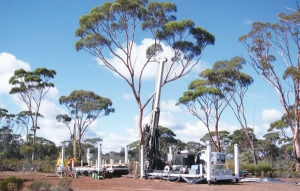Seven months after discovering the shallow Spotted Quoll nickel deposit, Western Areas (WSA-T, WSA-A) has completed a scoping study and plans to fast-track the project into production next year.
Results from the scoping study demonstrate that a low-cost open-pit mine at Spotted Quoll would generate cash flow of about A$300 million (US$285.5 million).
Spotted Quoll differs from most other high-grade nickel discoveries because it is shallow; the first drill hole intersected mineralization at a depth of just 100 metres. Parts of the deposit are as shallow as 30 metres deep, with grades of up to 10% nickel.
“Nickel with such high grades — or greater than five per cent nickel — at shallow depth, suitable for open-pit mining are very rare,” Julian Hanna, managing director of Western Areas, told The Northern Miner.
In the first stage, the company plans to develop a high-grade, low-cost, open-pit mine to a depth of about 160 metres over a four-year period.
The pit in the second stage would provide decline access to a high-grade underground mine with an as-yet unknown depth or mine life.
The underground mine would be developed concurrently with the completion of the open pit, so that production would move uninterrupted into underground ore.
The deposit lies 6 km south of Western Areas’ Flying Fox underground mine 400 km east of Western Australia’s coastal city of Perth.
“Flying Fox and Spotted Quoll are two of the highest-grade nickel deposits in the world,” Hanna says.
Both are still open at depth and diamond drilling is continuing.
“We think Spotted Quoll has the potential to rival Flying Fox,” he adds.
The average mineral resource grade at Flying Fox is about 6% nickel and the mine has a minimum seven-year mine life based on current reserves in just two zones, T1 and T5.
Flying Fox and Spotted Quoll lie on the same 25-km-long granite/ greenstone contact, which has seen very limited modern exploration or deep drilling.
“The last significant nickel discovery that I am aware of that didn’t conform to a known ‘geological type’ was Voisey’s Bay, which I think was discovered in 1993, fifteen years ago,” Hanna said.
Recently, an intersection of 18.3 metres grading 10.4% nickel with an estimated true width of 10 metres was discovered about 50 metres below the planned pit at Spotted Quoll.
According to the scoping study, the project could generate significant net cash flow over a four-year mine life. Assuming a nickel price of US$8 per lb., the potential net cash flow would tally A$220 million (US$209.3 million).
At US$10 per lb. nickel, potential net cash flow would reach A$300 million (US$285.5 million), and at US$12 per lb., the project would return A$380 million (US$361.5 million) in net cash flow. The potential cash flow does not include copper and cobalt byproduct credits.
The study estimated cash costs — after mining, treatment, transport and smelter/refining costs — at less than US$1.50 for each pound of nickel in concentrate produced. It also predicted an estimated life-of-mine average diluted grade of 5.1% nickel.
As for production, the study envisions an annualized production rate of about 8,000 tonnes nickel per year compared with the previous estimate of 5,000 tonnes.
Minimal additional capital spending is required to develop the mine with ore to be treated at the Cosmic Boy concentrator, due to be commissioned next year.
The scoping study estimates prestripping costs at A$25 million (US$23.8 million) and an additional A$5 million (US$4.7 million) in other infrastructure costs.
The optimized pit shell used in the scoping study excludes several significant recent drill-hole intersections. For example, hole WBD-064 intersected 18.3 metres at 10.4% nickel about 50 metres below the pit shell.
Currently, three drill rigs are drilling at between 200 and 400 metres depth and Western Areas expects to complete an updated mineral resource in the next three months.
Metallurgical test work of the primary nickel sulphide at Spotted Quoll indicates that a high-grade 16% nickel concentrate can be produced, the company maintains, and that “elevated arsenic values should be relatively easily suppressed to acceptable levels.”
Western Areas announced its initial mineral resource at Spotted Quoll in April. To a depth of 200 metres, the deposit hosts 545,600 tonnes grading 6.3% nickel for 34,500 tonnes contained nickel. The majority (87%) is in the indicated category.
Specifically, Spotted Quoll has an indicated resource of 473,600 tonnes grading 6.4% nickel, containing 30,140 tonnes of nickel. In the inferred category, the deposit hosts 72,000 tonnes grading 6.1% nickel for 4,370 tonnes nickel.
The resource was based on 36 surface diamond-drill holes completed between October 2007 and April 2008. Further drilling is required to test if the mineralization extends closer to surface. On June 2, the company announced that ongoing drilling had extended Spotted Quoll 250 metres below the initial mineral resource announced on April 18.
In Toronto, Western Areas recently traded at about $9.40 per share.
The stock has a 52-week trading range of $3.25-10.90 with 166.8 million shares outstanding.


Be the first to comment on "Western Areas to fast-track Spotted Quoll"